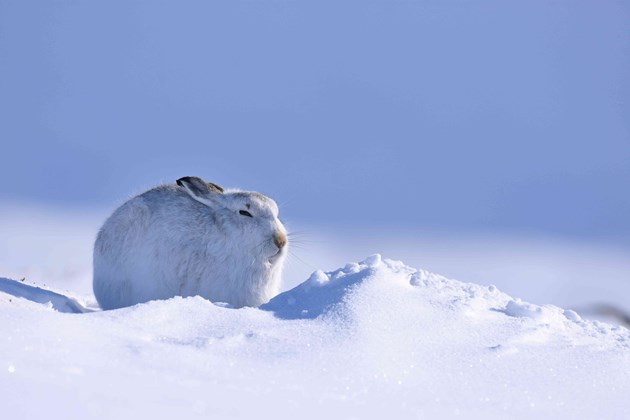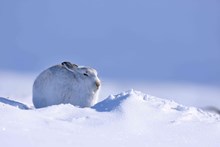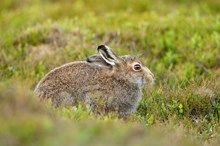22 March, 2021
Volunteers wanted for innovative Scottish mountain hare survey

Joint news release issued by NatureScot, BTO, the Mammal Society, GWCT and the James Hutton Institute
Volunteers are wanted for the first on-the-ground national survey to shed light on distribution and numbers of Scottish mountain hares.
The survey, which is launched today and will carry on throughout 2021, is calling on hillwalkers, naturalists and other outdoor enthusiasts to record sightings of the charismatic animals as they are out and about. No previous experience of wildlife surveys is necessary to take part.
Mountain hares are Scotland’s only native hare and an important species in the Scottish hills, and gathering more accurate information about them will help inform conservation efforts.
There is concern about the state of the mountain hare population and the possible effects of control measures. The available sources of information present a mixed picture of their conservation status, making it difficult to draw firm conclusions on population size and trends. The picture is further complicated by their naturally cycling populations, which can fluctuate by ten-fold or more over periods of about nine to ten years.
This project is a partnership of NatureScot, the British Trust for Ornithology (BTO), the Mammal Society, the Game & Wildlife Conservation Trust and the James Hutton Institute. It builds on previous work to develop suitable counting methods and seeks to complement these other counts to allow improved monitoring of mountain hares across their range in Scotland.
To participate, volunteers will need a smartphone with the free Mammal Mapper app. This can be used to record mammals during walks anywhere in Scotland. It contains an in-built ID guide to help participants identify mammals that they see, plus a section on upland birds which can now be recorded too. The BTO website also shows the highest priority areas for mountain hare monitoring (www.bto.org/mountain-hares). Volunteers are asked to take part as and when regional Covid travel restrictions allow.
Fiona Mathews from the Mammal Society said:
“Mountain hares are classed as Near Threatened in Britain by our recent Red List, highlighting the need for urgent action. Almost all of Britain’s mountain hares are found in Scotland, yet in most regions we have very little information on how they are doing. That is why we are calling on the public to help in our new project. You don’t have to be a specialist: all you need is to be out in the hills with a smartphone.”
Rob Raynor, a mammal specialist at NatureScot, said:
“Many people enjoy seeing mountain hares in the Scottish hills. Our priority is to make sure they remain a common sight. To do that, we need a better understanding of the existing population – something which this novel national survey will make possible by filling in the gaps in our knowledge. It will give us a better picture of mountain hare numbers, both regionally and nationally, and support decisions about how to maintain and conserve our native hare population.
“We’d like to encourage hillwalkers and anyone with an interest to contribute their sightings to this valuable project. We have an online training video and guidance, so participants who aren’t certain if they’ll be able to tell the difference between mountain hares, brown hares or rabbits can feel confident about their identification once they’re out in the hills."
Ben Darvill from the BTO added:
“Scotland’s outdoor enthusiasts can transform our understanding of mountain hares via this simple survey. It’s easy to log hare sightings while you’re out in the hills, and keen participants can also record the upland birds that they see, too. We hope that the project will add an enjoyable extra dimension to outdoor adventures.”
ENDS
MEDIA QUERIES
Contact the NatureScot media team on 0131 316 2655 or media@nature.scot.
Dr Ben Darvill, Development and Engagement Manager, BTO Scotland
07967 193259 or ben.darvill@bto.org
Bernardo Rodriguez-Salcedo, Media Manager, James Hutton Institute, Bernardo.RodriguezSalcedo@hutton.ac.uk, Tel: +44 (0)1224 395089 (direct line), +44 (0)344 928 5428 (switchboard) or +44 (0)7791 193918 (mobile).
Jo Wright, PR & Marketing Officer, The Mammal Society, pr@themammalsociety.org
02380 010983
Ross Macleod, Head of Policy (Scotland), GWCT, rmacleod@gwct.org.uk, 07773 898 625
Contact information
- Name
- NatureScot Media
- Telephone
- 0131 316 2655
- media@nature.scot
Notes to editors
Mountain hares are native to Scotland and are found in upland and mountainous regions. Mountain hares were given greater protection from 1 March this year, and it is now illegal to intentionally kill, injure or take mountain hares at any time unless a licence is obtained.
The survey project is about improving our understanding of how mountain hares are faring across their range in Scotland. It has come about directly as a result of recommendations made in earlier research commissioned by NatureScot (see reports 1022 and 1076). The information that is collected will contribute to that from other sources, including night-time hare counts using spot lamps in some areas – often grouse moors, where the management can be favourable to mountain hares. (This was another recommendation from the commissioned research). The primary focus is in areas where the spot lamping method is often not appropriate due to difficult terrain and/or low hare population density. It is in these more rugged areas, mainly in the west and north-west Highlands (where existing survey coverage is poor) that this volunteer-based approach may prove particularly valuable. In the autumn, a small number of volunteer counts will need to take place in areas overlapping with spot lamp counts, to help us better understand how the two methods compare with each other.
The Game & Wildlife Conservation Trust is an independent wildlife conservation charity which carries out scientific research into Britain’s game and wildlife. We advise farmers and landowners on improving wildlife habitats. We employ 22 post-doctoral scientists and 50 other research staff with expertise in areas such as birds, insects, mammals, farming, fish and statistics. We undertake our own research as well as projects funded by contract and grant-aid from Government and private bodies. The Trust is also responsible for a number of Government Biodiversity Action Plan species and is lead partner for grey partridge and joint lead partner for brown hare and black grouse. www.gwct.org.uk
The James Hutton Institute is a world-leading scientific organisation encompassing a distinctive range of integrated strengths in land, crop, waters, environmental and socio-economic science. It undertakes research for customers including the Scottish and UK governments, the EU and other organisations worldwide. The Institute has over 500 employees and 120 PhD students and with associated bodies and spin-out companies there are over 750 people working on our campuses. The Institute takes its name from the 18th century Scottish Enlightenment scientist, James Hutton, who is changed the way we think about our world with deep insights into land, soils, crops and the climate and is widely regarded as the founder of modern geology. He was also an experimental farmer and agronomist. More information at www.hutton.ac.uk.
The British Trust for Ornithology (BTO) is the UK’s leading bird research charity. A growing membership and up to 60,000 volunteer birdwatchers contribute to BTO’s surveys, collecting information that underpins conservation action in the UK. BTO maintains a staff of 100 at its offices in Thetford, Stirling, Bangor (Wales) and Belfast (Northern Ireland), who analyse and publicise the results of surveys and projects. BTO’s work is funded by BTO supporters, government, trusts, industry and conservation organisations. More information at https://www.bto.org/
The Mammal Society: one in four of our native mammals is threatened with extinction, and many others are in decline. With Britain now recognised as one of the most nature-depleted countries in the world, urgent action is needed. The Mammal Society is working to give our wildlife a better future by:
- Keeping a constant watch on the conservation status of our mammals and making this information freely available
- Making conservation more effective by providing guidance on what to do and where to do it
- Educating the public and professionals about wild mammals, training people to survey them, and sharing the latest research
- Working in partnership to restore native mammal populations and re-establish functional ecosystems
More information at https://www.mammal.org.uk/
NatureScot is Scotland's nature agency. We work to enhance our natural environment in Scotland and inspire everyone to care more about it. Our priority is a nature-rich future for Scotland and an effective response to the climate emergency. For more information, visit our website at www.nature.scot or follow us on X at https://x.com/NatureScot
’S e NatureScot buidheann nàdair na h-Alba. Bidh sinn a’ neartachadh àrainneachd na h-Alba agus a’ brosnachadh dhaoine gu barrachd suim a chur ann an nàdar. Tha e mar phrìomhachas againn gum bi nàdar na h-Alba beairteach agus gun dèilig sinn gu h-èifeachdach le èiginn na gnàth-shìde. Tha an tuilleadh fiosrachaidh aig www.nature.scot no air X aig https://x.com/NatureScot


